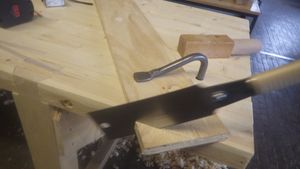Holdfasts: Difference between revisions
m location from template |
NitramLegov (talk | contribs) m German |
||
| Line 1: | Line 1: | ||
{{ToolInfoBox | {{ToolInfoBox | ||
|tool name=Holdfasts | |tool name=Holdfasts | ||
|image=holdfast and Ryoba.JPG | |german=Werkstückniederhalter|image=holdfast and Ryoba.JPG | ||
|synonyms="holddowns"; DE: ''"Werkstückniederhalter<br>für runde Löcher"'' | |synonyms="holddowns"; DE: ''"Werkstückniederhalter<br>für runde Löcher"'' | ||
|type=work holding | |type=work holding | ||
Latest revision as of 16:53, 29 May 2022
| ToolInfoBox Holdfasts | |
|---|---|

| |
| Synonyms: | "holddowns"; DE: "Werkstückniederhalter für runde Löcher" |
| Type: | work holding |
| Material: | usually wooden workpieces |
| Used with: | mallet, compatible workbench |
| Location: | Lukas' workbench |
| Access Requirements: | ask Lukas |
| Similar (More or Less): | clamps, vises |
Holdfasts are solid pieces of round steel with a tip that is shaped for work holding. A holdfast looks like a "7": the short end lies on your workpiece and the long end is inserted into a matching hole in the workbench.
These traditional tools date back before vises became common, but they are still interesting for hand tool woodworking!
Use
By smacking it with a mallet, a holdfast is wedged into the hole (hit from above) or released (hit from "behind").
Holes need to go all the way through the workbench (top or leg shouldn't matter) so various thicknesses of workpieces can be held and are best drilled with a suitable auger bit
To be tested: what if the holdfast does not reach the other side of the bench, does it need to stick out?
Gramercy Tools Holdfasts
Lukas has two holdfasts (forged by Gramercy Tools):
- for 3/4" holes (approx. 19 mm)
- minimum bench thickness: 45 mm (not verified)
- maximum bench thickness: ?
- holding capacity (height): 240 mm minus bench thickness (not verified)
- prone to leaving marks on the held piece - should be padded with pieces of leather!